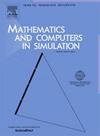Convergence analysis of a Schrödinger problem with moving boundary
IF 4.4
2区 数学
Q1 COMPUTER SCIENCE, INTERDISCIPLINARY APPLICATIONS
引用次数: 0
Abstract
In this article, we present the mathematical analysis of the convergence of the linearized Crank–Nicolson Galerkin method for a nonlinear Schrödinger problem related to a domain with a moving boundary. The convergence analysis of the numerical method is carried out for both semidiscrete and fully discrete problems. We establish an optimal error estimate in the -norm with order , where is the finite element mesh size, is the time step, and represents the degree of the finite element polynomial basis. Numerical simulations are provided to confirm the consistency between theoretical and numerical results, validating the method and the order of convergence for different degrees of the Lagrange polynomials and also for Hermite polynomials (degree ), which form the basis of the approximate solution.
一类带移动边界Schrödinger问题的收敛性分析
在这篇文章中,我们给出了线性化的Crank-Nicolson Galerkin方法的收敛性的数学分析。对半离散和全离散问题进行了数值方法的收敛性分析。我们在l2 -范数中建立了O阶(τ2+hs)的最优误差估计,2≤s≤r,其中h为有限元网格尺寸,τ为时间步长,r−1表示有限元多项式基的程度。通过数值模拟验证了理论结果与数值结果的一致性,验证了该方法在p≥1次的拉格朗日多项式和p=3次的Hermite多项式下的收敛阶,从而构成了近似解的基础。
本文章由计算机程序翻译,如有差异,请以英文原文为准。
求助全文
约1分钟内获得全文
求助全文
来源期刊

Mathematics and Computers in Simulation
数学-计算机:跨学科应用
CiteScore
8.90
自引率
4.30%
发文量
335
审稿时长
54 days
期刊介绍:
The aim of the journal is to provide an international forum for the dissemination of up-to-date information in the fields of the mathematics and computers, in particular (but not exclusively) as they apply to the dynamics of systems, their simulation and scientific computation in general. Published material ranges from short, concise research papers to more general tutorial articles.
Mathematics and Computers in Simulation, published monthly, is the official organ of IMACS, the International Association for Mathematics and Computers in Simulation (Formerly AICA). This Association, founded in 1955 and legally incorporated in 1956 is a member of FIACC (the Five International Associations Coordinating Committee), together with IFIP, IFAV, IFORS and IMEKO.
Topics covered by the journal include mathematical tools in:
•The foundations of systems modelling
•Numerical analysis and the development of algorithms for simulation
They also include considerations about computer hardware for simulation and about special software and compilers.
The journal also publishes articles concerned with specific applications of modelling and simulation in science and engineering, with relevant applied mathematics, the general philosophy of systems simulation, and their impact on disciplinary and interdisciplinary research.
The journal includes a Book Review section -- and a "News on IMACS" section that contains a Calendar of future Conferences/Events and other information about the Association.
 求助内容:
求助内容: 应助结果提醒方式:
应助结果提醒方式:


